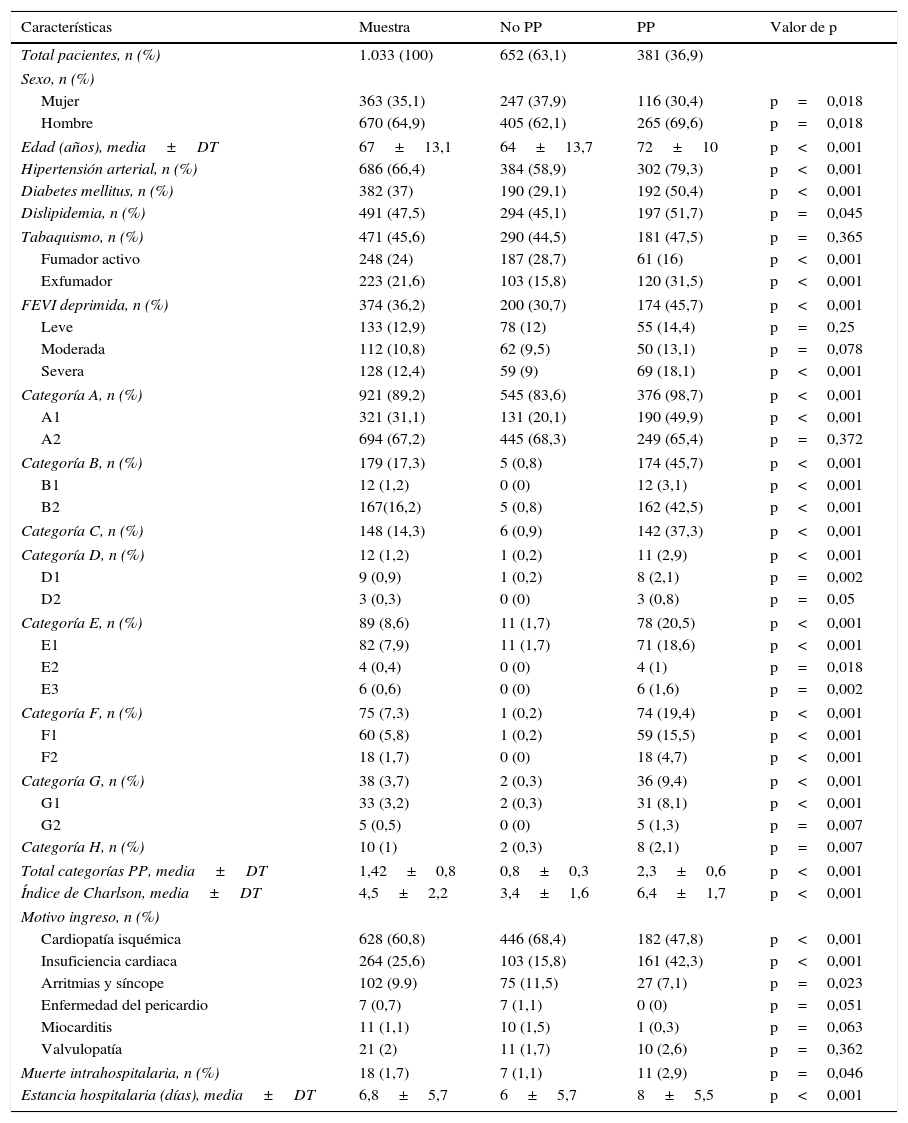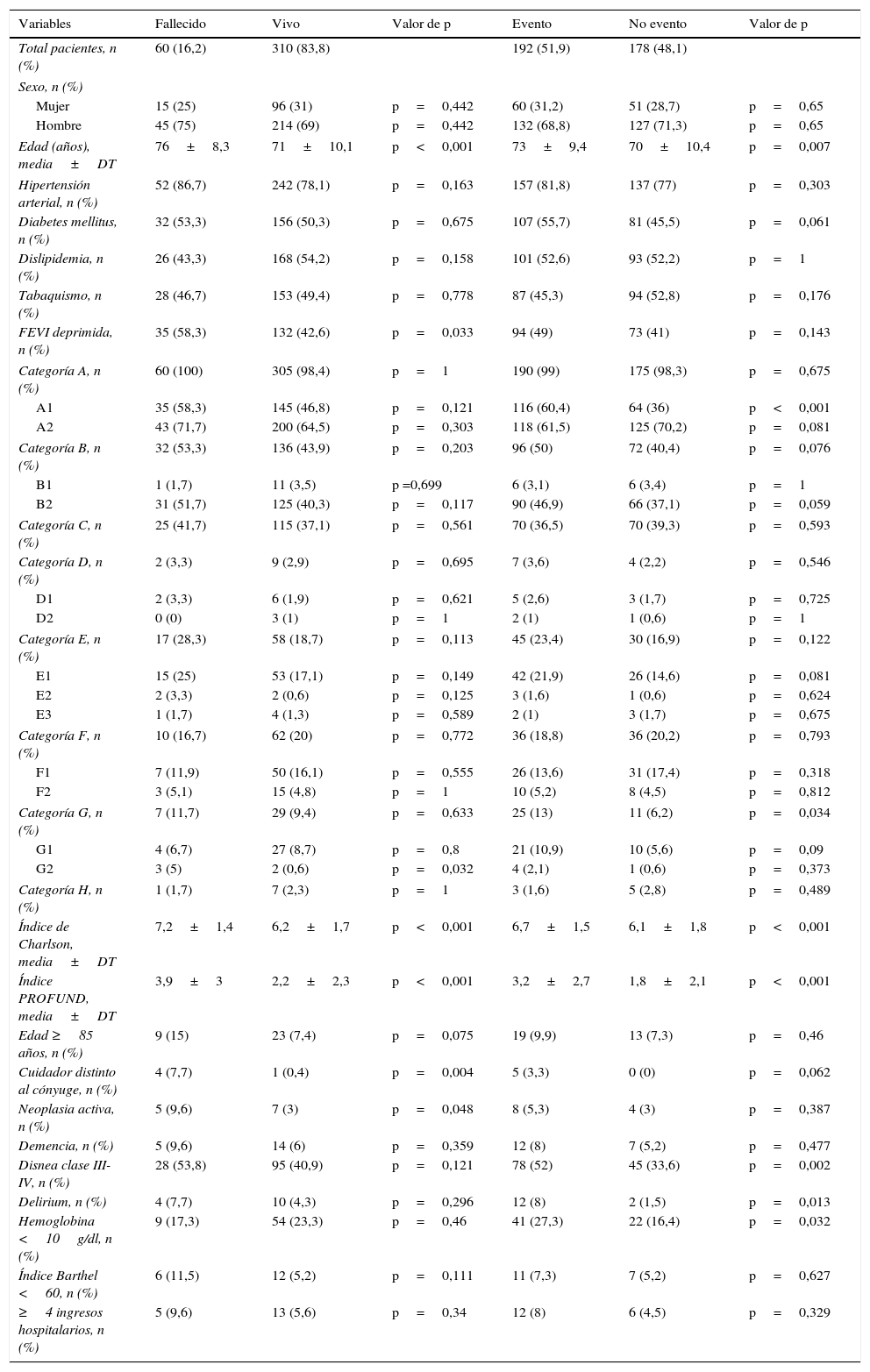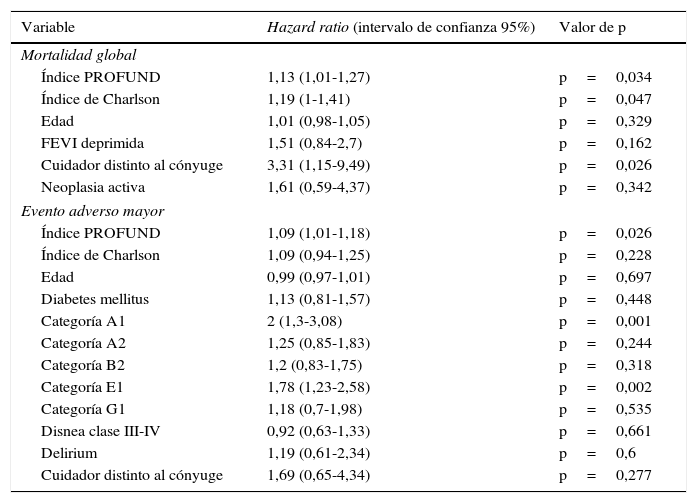El objetivo del estudio fue conocer la prevalencia de pluripatología y la utilidad del índice PROFUND para la estratificación pronóstica de los pacientes pluripatológicos en una unidad de hospitalización de Cardiología.
Pacientes y métodosSe analizaron de forma consecutiva todos los pacientes ingresados en 2012 en el servicio de Cardiología. Se registraron las comorbilidades, estancia y mortalidad intrahospitalarias, y los índices de Charlson y PROFUND. En los pacientes pluripatológicos, se registraron además los reingresos y la mortalidad durante un año de seguimiento.
ResultadosSe incluyeron 1.033 pacientes (67±13,1 años, 35% mujeres); 381 (36,9%) fueron pluripatológicos, con un índice de Charlson de 6,4±1,7 y PROFUND de 2,5±2,5. Comparados con el resto, los pluripatológicos fueron mayores (72 vs. 64 años, p<0,001), tuvieron más mortalidad (2,9% vs. 1,1%, p=0,046) y estancia intrahospitalarias (8±5,5 vs. 6±5,7 días, p<0,001) e ingresaron más por insuficiencia cardiaca (42,3% vs. 15,8%, p<0,001). El índice PROFUND se asoció de manera independiente con la mortalidad global (hazard ratio[HR]=1,13, intervalo de confianza [IC] del 95%: 1,01-1,27, p=0,034) y con la existencia de eventos adversos mayores en el seguimiento a 12 meses (HR=1,09, IC del 95%: 1,01-1,18, p=0,026).
ConclusionesUn alto porcentaje de los pacientes ingresados en Cardiología fueron pluripatológicos. Estos presentaron mayor prevalencia de factores de riesgo cardiovascular, mayor estancia y mortalidad intrahospitalarias. El índice PROFUND predijo de forma independiente la mortalidad y los acontecimientos adversos durante el seguimiento.
The aim of this study was to understand the prevalence of comorbidities and the usefulness of the PROFUND index for the prognostic stratification of patients with comorbidities in a hospital cardiology unit.
Patients and methodsWe consecutively analysed all patients hospitalized in 2012 in the department of cardiology. We recorded the comorbidities, length of stay, hospital mortality, Charlson indices and PROFUND indices. In the patients with comorbidities, we also recorded the readmissions and mortality during a 1-year follow-up.
ResultsThe study included 1,033 patients (mean age, 67±13.1 years; 35% women), 381 (36.9%) of whom had comorbidities, with a mean Charlson index of 6.4±1.7 and a mean PROFUND index of 2.5±2.5. Compared with the other patients, the patients with comorbidities were older (72 vs. 64 years, p<.001), had a higher mortality rate (2.9% vs. 1.1%, p=.046) and longer hospital stays (8±5.5 vs. 6±5.7 days, p<.001) and were more often admitted for heart failure (42.3% vs. 15.8%, p<.001). The PROFUND index was independently associated with overall mortality (hazard ratio [HR], 1.13; 95% CI: 1.01-1.27; p=.034) and with the presence of major adverse events during the 12-month follow-up (HR, 1.09; 95% CI: 1.01-1.18; p=.026).
ConclusionsA high percentage of patients hospitalized in the department of cardiology had comorbidities. These patients had a higher prevalence of cardiovascular risk factors, longer stays and greater hospital mortality. The PROFUND index independently predicted mortality and adverse events during the follow-up.
Artículo
Diríjase desde aquí a la web de la >>>FESEMI<<< e inicie sesión mediante el formulario que se encuentra en la barra superior, pulsando sobre el candado.

Una vez autentificado, en la misma web de FESEMI, en el menú superior, elija la opción deseada.

>>>FESEMI<<<











